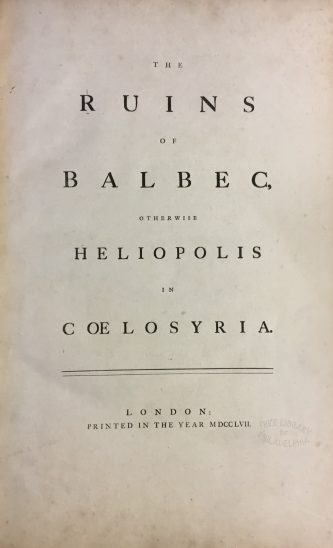The Ruins of Balbec, otherwise Heliopolis, in Coelosyria.
Wood, Robert.
Synopsis
FIRST EDITION of a magnificent work published to wide acclaim and influential on contemporary British Buildings. Wood, accompanied by James Dawkins, John Bouverie and the Italian artist and architect Giovanni Battista Borra, travelled extensively in the Levant, reaching the relatively not visited sites of Palmyra and Balbec in 1751. He published The Ruins of Palmyra in 1753, and The Ruins of Balbec four years later.
Robert Wood was a British traveller, classical scholar, civil servant and politician. In 1750-1751 Wood travelled around the Levant with two wealthy young Oxford scholars James Dawkins and John Bouverie (who died of a fever early in their expedition) and an Italian draftsman Giovanni Battista Borra. Their primary goal was to explore the Troad and locate the key sites mentioned by Homer. Moving south into Syria, they then took careful measurements and drawings of the ancient Roman ruins of Palmyra and Baalbek. The results of these were published in 1753 and 1757 in both English and French editions and were among the first systematic publications of ancient buildings. Both works were of great influence on neoclassical architecture in Britain, Continental Europe and America. From 1753 to 1756, Wood was the tutor and travelling-companion (or Bear-leader as such men were known at the time) of the young Duke of Bridgewater, the richest peer in England, in making the Grand Tour.
Wood’s first voyage to the Levant was made in 1742. In 1750 another expedition was suggested by James Dawkins and John Bouveri. It is likely that the prime mover was Dawkins and that he intended to model the journey on Stuart and Revett’s activities in Athens, which he was helping to finance. The three men accompanied by the architect and draughtsman Giovanni Batista Borra, toured Asia Minor, where Bouverie died. The others then returned to Athens where they joined Stuart and Revett. In 1751 Wood, Dawkins and Borra returned to Syria with some difficulty they managed to reach Palmyra and then went on to Baalbec, “both of Wood’s publications on these unfamiliar sites were important architectural source books” (Blackmer). Borra’s topographical views in the two works were engraved by Thomas Major and probably suggested to him the form of his later work on Paestum.
Bibliographic References: Blackmer 1835; BAL RIBA 3706; Fowler 444; Harris 936; Cohen-de Ricci 916; Röhricht 1449; not in Atabey; Millard II, 94 (French edition); Berlin Kat. 1887.






